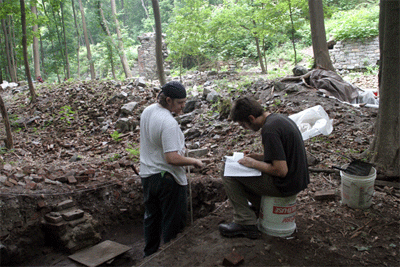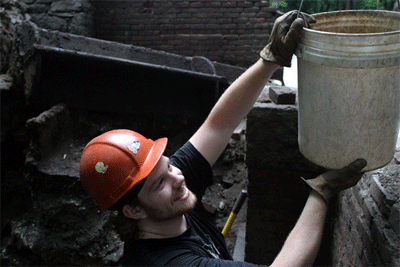Greetings and salutations from the field!
My name is Cal Wacker, a student at Michigan Technological University (MTU) spending my second straight field season at the West Point Foundry. I have been practicing archaeology for several years now, first working for two years in Cultural Resource Management (CRM) around southeastern New York and Connecticut as a ‘shovelbum’ and now participating in MTU’s West Point Foundry excavations while working towards my undergraduate degree in Archaeology. The Foundry excavation is a unique site unlike anything I’ve worked on before. Returning for another season and a longer term excavation is a wonderful change of pace for me, I rarely get to return to a site a second time, excavate another area of interest, and expand upon my current understanding of the site at large.
This week has seen the addition to the crew of volunteer Richard Douty all the way from Missouri, and the return of Dr. Tim Scarlett from MTU. Richard is participating in his first field school, but dived right in, helping Mike Deegan to profile and close unit N41.04 E07.14. Richard and Mike then opened a new unit in the projected doorway of the molding shop. The plan was to expose a buried brick wall that likely was constructed after the original molding shop. Mike and Richard not only uncovered the continuing buried brick wall, but part of the tramway rail leading into the molding shop while excavating.

Cal and Seth pause to document their findings
The 3 meter by 2 meter unit that Janelle Schaeffer and I had excavated last week was finally closed. This excavation unit had uncovered a corner of the 1835 molding shop expansion. Field supervisor Dan Trepal took over the mapping and photographing of the unit, and moved me over to the larger cupola furnace unit that Seth DePasqual, Amy Bastion, and Yolanda Beltran had been excavating. Digging in the cupola furnace focused in the southern section, where further brick pillar beneath the bluestone footing, and large granite bases have been uncovered. By Friday the full extent of the cupola pillars stood exposed. A stone floor had been uncovered that the granite bases of the pillars rest on, close to 9 feet below the current surface of the site. Even more exciting than the culmination of two months of excavation is the discovery of several 8-inch diameter holes drilled right into the stone floor around the bases of the cupola pillars. The purpose of these features is not yet known, but the presence of wood in each hole suggests a possible construction use, perhaps as bases for scaffolding during installation of the cupola furnace.
This week wrapped up our electronic mapping data collection with the total station leaving on Friday. Yolanda and Elizabeth spent many hours collecting the locations of wall segments, bottoms of excavation, and large iron artifacts. This information will be incorporated into an electronic map during the school year.
The final surprise for the week was a visit to the West Point Foundry Preserve by Lynn Scarlett, Deputy Secretary of the United States Department of the Interior. Lynn was accompanied by Scenic Hudson Land Trust president Ned Sullivan, Commissioner of the New York State Office of Parks Carol Ash, and Recreation and Historic Preservation and Deputy Commissioner Erik Kulleseid. Others from the Open Space Institute, Adirondack Mountain Club, and The Highlands Coalition also toured the site. The group came to witness first hand the unique aspects of the West Point Foundry including its history of industrialization, modern environmental reclamation, and ongoing archaeological research.
With only ten working days left, we’ll be working hard to wrap all of our work up, if you get a chance, stop by before we close up our excavations and see what all the fuss is about.
Take care!
|

This week’s author, Cal lifts a bucket from the foundation of the cupola units
|



